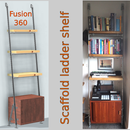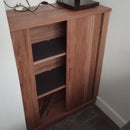Introduction: Pizza Cutter From Discarded Saw Blade
Last week there were some workmen on my street laying fibre optic cables in the pavement (sidewalk) which involved using a road saw to cut the channels. A day after they left I noticed an old saw blade by the tree outside of my house which they must have left there after changing the blade. It was my lucky day!
I've always liked the thought of making a knife but I have loads of them already, so I decided to make a pizza cutter. We have pizza once a week (at least) and is a family favourite so it will be used a lot.
Supplies
Materials
Saw blade
Wood for the handle and base - I used Sapele and Ash
Tools
Angle grinder and cutting wheels
Bench grinder
Sanders
Saws
Step 1: Find a Saw Blade!!
So this was the view just outside of my house. I first saw it when we all went for our 'once a day permitted Covid exercise' walk and it got my brain ticking away.
I haven't really done much metal work and not even tempted to make a knife so I was originally thinking of that. However as I have a lot of kitchen knives already I thought I'd make a pizza cutter. I sketched a few ideas down and went for one with curves and sweeping lines.
The next day I went out and got it after seeing someone else eyeing it up.....that blade was mine!
Keeping the above in mind this Instructable is how I have done it and may not be the best, correct or safest way to make a blade - but it worked for me with minimal injuries!
Step 2: Making the First Cut
I started by marking on a rough shape of the blade looking at cutting a straight line and cutting all the teeth off.
I clamped the edge of the blade on to the outer jaw of my vice so the cutting line was above the gap. I put a cutting blade on to my angle grinder and started to cut the first line. This did take quite a long time as I went fairly slowly not knowing how the grinder would react. I also kept checking the sparks behind me to make sure they weren't setting anything on fire.
I did find it very difficult to follow the line though as there were far too many sparks flying about so I couldn't see it....maybe that's just metal work?
Note that I did wear a face shield and very glad I did.
Step 3: Cut the Curve
I had a large tub of paint which I used to draw a radius on the blade. As there were teeth already on the edge of the curve I didn't need to make any relief cuts as these would serve the purpose.
I then chopped off the teeth one by one trying not to heat up the metal too much. I did heat up the metal too much, as you can see by the darker metal in places, but left these as they were to deal with next and a little later.
I then changed the disc to a grinding disk and ground the rough cuts a little less rough and tried to get rid of the burnt metal parts.
Step 4: File
I then used a file (not sure what type) to make the final shape and to square off the edges.
Step 5: Grinding a Bevel
To grind the bevel I used my bench grinder, I normally use to sharpen wood turning chisels, with an angled tool rest. I set the angle to as steep as I could and moved the blade from left to right on one side, then turned it over and repeated. Then did this another 40 or 50 times until I had a sharp blade. I did take this grinding very slowly so I didn't heat it up too much, doing this without gloves lets you know if you are heating it too much, if you can't hold it it's probably too hot.
At this point many people heat treat the blade. Having read around there is mixed ideas about doing this or not for something like a food knife. I left it how it was which may leave the metal a bit softer but it's only for pizza and it will be easier to sharpen.
Step 6: Sanding the Faces
Next I cleaned up the faces of the blade with 80, 120, 180 and 320 grit sand paper and a random orbital sander. It didn't work great but good enough.
Step 7: Cut Wooden Handle
Now the blade was pretty much finished I went on to the wooden handle. I decided to make the handle out of three bits of wood two on the outside and a middle section which was as thick as the blade.
I used Sapele for the main part of the handle and some Ash for the middle part.
I started off by sketching the shape I wanted on the saw blade and transferred this to the wood when I was happy with the shape and size. I then cut the first part on the band saw and shaped with a bobbin sander. I rough cut the other two bits.
Step 8: Finish Handle
I the glued on the middle section to the shaped outer part and cut it to size with a flush trim bit in the router once the glue had set. To cut the other outer part to size I screwed it to the other in the same place I was going to place some metal dowel later, I could then use the flush trim bit as before.
I then finished the edges with an ogee but to give it a better feel in the hand.
Step 9: Gluing
I then needed to glue the wood and blade together so started off by drilling some 6mm holes in to the blade and the wooden handles so I cut add a couple of 6mm bolts through to act as a dowel.
I then used some epoxy resin to glue all the bits together, aligning them all with the bolts and finally clamping them all together. I then left it overnight to set.
Step 10: Stand
Due to the size and shape of the cutter I needed to make a stand to keep it in. As with the handle this was going to be made out of three pieces.
I decided to make the base of the stand wider than the top so put an angle of around 5 degrees on the bandsaw before cutting the side pieces. I then cut the middle part to slightly thicker than the blade so the cutter went in and out easily. I added a curve to the top to the same radius as the blade and curves the edges.
Once I was happy with the general shape I glued it all together.
When it was dry I added a further curve to the bottom using a bobbin sander. This curve was cut at right angles to the faces so the bottom curve was V-shaped in cross section with the point meeting in the middle.
Step 11: Finishing
Now everything was complete all I needed to do was sand all the wood to 320 grit and apply a few coats of oil for protection. Finally I sharpened the blade using a whetstone.
All in all I am happy with the finished cutter and it works really very well - as it was my first project making something quite involved out of metal it seemed to go fairly smoothly.
If you have any hints or tips re. metal working/blades/safety etc. please feel to post a message. Any info. will be great the next time I make something metal related. I still have quite a bit of saw blade left.
If you have found this Instructable helpful, useful or interesting I would be grateful if you could vote for it in the pizza contest.
Thanks for reading!

Participated in the
Pizza Speed Challenge 2020











